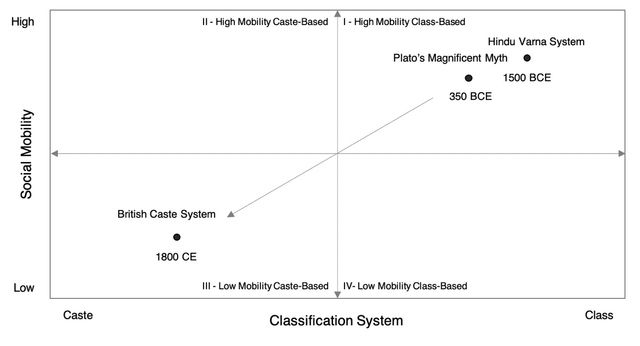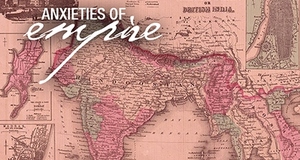Deconstructing Social Classification and Mobility: The Hindu Varna System, Plato's Magnificent Myth, and the British Caste System
By
2021, Vol. 13 No. 12 | pg. 1/1
IN THIS ARTICLE
KEYWORDS
AbstractThis research elucidates the striking parallelism between the Hindu Varna System and Plato's Magnificent Myth through an unorthodox view of their class-based classification, social mobility, and meritocracy while arguing that these stem from the Arguments from Division of Labor and Biological Determinism. Furthermore, it establishes that the Caste System introduced in India by the British in the 18th Century fundamentally differs from the systems followed in ancient India and Athens and investigates the fundamental forces and the motivations behind its implementation. Lastly, the paper conducts the first rigorous comparative study of the three systems by proposing a new framework to explore the transformation from a class-based high mobility Hindu society to a rigid caste-based society during colonialism and illustrate the true nature of each system. The study of the similitude between Eastern and Western thought stretches back over 100 years with Sarvapalli Radhakrishnan’s book “Eastern Religions and Western Thought,” A.N. Marlow’s paper on “Hinduism and Buddhism in Greek Philosophy” and B R Ambedkar's “Philosophy of Hinduism.” These works, amongst few others, highlight the similarity of the Hindu Varna System and Magnificent Myth, but either viewing the structures as rigid caste-based systems or tangentially commenting in Pre-Independence era works. A paucity of studies investigate the parallelisms between the two systems as based on class and encouraging equality of opportunity, whence such analyses are essential in understanding the systems individually. This research aims to separate the two fundamentally different systems of social classification that have existed in Indian history before and after the advent of the 19th Century into the fluid Hindu Varna System and the socially immobile authoritarian British Caste System, which are often treated interchangeably. As a result, the research conducts the first rigorous parallel analysis of the three systems that have been proposed, some implemented, at different periods in history, namely, the Hindu Varna System, Plato’s Magnificent Myth, and British Caste System.In Part A, the study illustrates the resemblance between the older two class systems through the unorthodox lens of the structures encouraging social mobility and equality of opportunity. It further exemplifies that the systems promote strikingly identical classes that are segregated based on the same Arguments from the Division of Labor and Biological Determinism. In Part B, the research traces the currently understood Caste System to the fundamental shift that occurred in the British's latest implementation of the system in India and attempts to ascertain the dominant forces and the attitudes that brought about the transition. Lastly, it develops a new framework to compare the older class-based societies with the rigid caste-based hierarchy created in colonial India and understand the true nature of structures. The Hindu Varna System & Plato's Magnificent MythWhat is the Hindu Varna System?Hinduism began sometime between 2500 - 1500 BCE and differs significantly from other religions - in that it is not a religion. It is more aptly referred to as Hindu Dharma (Chakravarti, 2001), a philosophy or way of life that proposes tenants on how to live life. Unlike Abrahamic religions, it has no holy book that enforces a set of commandments. No one who chooses to follow the principles laid out in the philosophy is compelled to accept any specific part of it and can choose to adopt any or all elements they see fit. One of the aspects of the philosophy was the Varna system, first claimed to have been written in the most ancient book of Hindu scripture - the Rig Veda. The same system is mentioned and discussed in the epics - the Bhagavad Gita and Mahabharata - supposedly written much later between 500 BCE and 200 CE (Austin, 2019). The Varna system is a proposed four-fold class hierarchy based on occupation with four “Varnas”: Brahmins - priests, teachers - on top; followed, in order, by Kshatriyas – warriors; Vaishyas - farmers, traders, merchants; and Shudras – laborers; to ensure people who are best suited for particular occupations occupy them and do not interfere in others' work. Varnas are distinct from Jatis - another system of social classification. Jati refers to any general characteristics that a group has in common due to their birth and can range from geographical location, tribes, linguistic or religious group1. Traditionally, they were most commonly used to identify geographically similar communities, such as Rajputs. The original social classes are introduced in the Purusa Sukta of the Rig Veda, with the primordial Purusa (man) sacrificing himself to form Brahmin, Rajanya (instead of Kshatriya), Vaishya, and Shudra classes forming the head/mouth, arms, thighs, and feet, respectively:
Brahmins are considered the intelligent and most powerful Varna because of their wisdom and education and represent the head. In the same way, Kshatriyas, considered the warrior class, were created by arms, representing strength. Vaishyas are hardworking traders and farmers embodied by the legs. Shudras are revered for their service and are thus symbolized by the feet of the Purusa2. What is Plato's Magnificent Myth?The famous Magnificent Myth first features in The Republic, a dialogue written by Plato adopting his teacher's voice, Socrates, in 375 BCE Athens. The conversation between Socrates and numerous other philosophers is centered around creating a just city-state as the intellectuals of the Athenian society were troubled by its unproductivity and injustice. One of the fundamental pillars of the ideal society is the system of class-based classification that he proposes. However, he believes the best way for its dissemination is through the use of a Magnificent Myth - the Myth of the Metals. Plato’s introduction of this particular Magnificent Myth comes near the end of Book III of the Republic (414-15 e); however, its preparation begins much earlier in the text, and arguments for its necessity continue deep into the 4th and even the 5th book. The Magnificent Myth has two distinct parts. The first part explains that the citizens are all autochthonous, literally born from the Earth and gestated under it3. Everything up until now was a dream while the Earth was breeding them. Plato aims to establish a unified brotherhood amongst all the citizens in caring for each other and protecting the city.
The Earth is not their literal mother, and Plato does not try to eliminate the role of women but uses the Earth as a metaphor to express the nourishment it provided. Moreover, it does not seem plausible that the Magnificent Myth argues that newborn babies are born from the Earth during the bio-birth, but instead refers to a second birth at the age of 18-20 after completing their education underground (Hourani, 1949). In the second part, Plato introduces the famous Myth of the Metals, in which, despite a brotherhood, the Gods have deposited different metals in the souls of each citizen and further enumerates the overall structure of the proposed society based on the myth. The society is expressed to comprise of four distinct social classes through the analogy of the hierarchy of metals. The Philosopher-Kings comprising of Gold are positioned at the crest, followed by the Auxiliaries - helpers of the rulers and the warriors - in the middle characterized by Silver, the Farmers symbolized by Iron, and lastly, the Manual Workers at the bottom expressed as Brass.
However, this study will focus on the second part of the Magnificent Myth and entertains the first part solely because of the concept of bio-birth and second birth that we will return to later in the paper. Why should there be a classification of society?Hinduism and Plato believe in ultimately creating a society that is just, happy, and productive. In order to do so, they believe it is crucial to establish the duties of each person and thus employ the Argument from the Division of Labor. In the Gita, Krishna emphasizes the importance of each citizen fulfilling one's duties without expecting any fruit to be a good citizen (Bhagavad Gita, ii, 47). The prevailing argument from the Division of Labor and responsibilities is aptly applied here to illustrate that the completion of an individual’s duty commitments is beneficial to the person themselves and the collective betterment of society. The individual and society are conveyed as interdependent, and each person is necessary to support the balance. Hence, each person must have a clear role that would result in greater social harmony in society. Similarly, the reason for the necessity of such a state is explained by Plato when he explains the concept of justice in an individual as “the minding of one's own business and not being a busybody” (Rep. 433 b). Each person must fulfill one's roles and responsibilities and follow a strict principle of non-interference. This can only be achieved when each individual is fully aware of his or her role and does not meddle in the works of others. As a result, such a system is needed to distribute and cement the roles of each person. Therefore, social justice will be in having each person fulfill one's sense of duties based on one's abilities, increasing productivity and happiness of the individual and, in turn, of society. What should the classification be?It is evident from the introductions that both systems are based on strikingly similar classes that are a function of occupation and each person's role in the overall society. At the top of the structure lie the intellectuals, the Brahmins in Hindu society, and Philosophers in Athenian society. Their function is to live their life to quench their thirst for knowledge and seek the truth through the study of philosophy. Their moral duty is to guide society through deep, thoughtful, and selfless acts of consciousness. A key distinguishing factor in their personality is an aversion to the pressure of immediate needs and all bodily and monetary pleasures or desires. They are followed by soldiers through the Kshatriya’s and Auxiliaries. The strongest-willed and powerful population of the society, they are men who are never terrified, never daunted by difficulty, and men who consider a retreat to be bitter than death (Radhakrishnan, 1939, p. 359). They are markedly known for their undeterred fight to protect the land despite all dangers and difficulties. The third class is the Vaishyas or Farmers. They are engaged in commerce and industry through the practice of agriculture or trading. They are characterized by their enjoyment in acts of giving and taking and in possessing a utilitarian, practical mind. Bent on the efficient exploitation of natural resources, they are also marked by humanity and ordered benevolence. The last and fourth variety of human nature is the Shudra or Manual Workers. They find their outlet in work and service, as labor is the basis of all human relations. In contrast to the higher classes, the lower classes fulfill their duties for the gratification of their primary needs, and they tend to live a life of indolence and inertia. Their chief contributors are instinctive obedience and a mechanical discharge of duty. However, there is one significant dissimilarity. Plato believes that philosophers are the ones who should be the rulers of his ideal oligarchical society as they are most suited to make logical decisions for the people. On the other hand, Brahmins are expected to act as priests and not partake in political structures except advising the rulers. Hinduism believes that anyone immediately and deeply concerned with the exercise of power cannot be completely objective. Thus, someone from any other class should be the ruler (Radhakrishnan, 1939, p. 359). This difference marks the emergence of differences between the two structures with time. After proposing the structure, the Varna System and the Magnificent Myth employ the same mechanism for the authority of belief in the system: God. The distribution of metals is attributed to the work of the Gods to call for higher authority and promote the structure as the result of divine intervention. Unequivocally, all theories about the origin of the Varna system are also from God, either Vishnu, Brahma (Rig Veda), or Krishna (Gita)5. Radhakrishnan (1939) asserts that the importance of regarding the fourfold division of society as the ordinance of God or the dispensation of the spirit is the suggestion to the collective societal thinking “that spiritual wisdom, executive power, skilled production, and devoted service are the indispensable elements of any social order” (p. 356). On what basis should people be assigned classes?After stressing the importance of having an established division of labor through a class-based classification of society, both systems further demonstrate that each person in society is better suited for a specific occupation using the Argument from Biological Determinism. They assert that since people inherently contain different aptitudes, and it is on the basis of this, they are assigned classes. Thus, classifying people should not be a problem. The Maitrayaniya Upanishad, or more famously, the Bhagavad Gita, proposes to explain the requirement of the Division of Labor as they introduce the concept of Gunas (most nearly Qualities in English). There are said to be three Gunas, namely, Sattva (Sattvic), Rajas (Rajasic), and Tamas (Tamasic). Sattva is the quality of being virtuous, thought through, and related to wisdom; Rajas relates to passion, valor, and activity; and Tamas refers to ignorance, inertia, and laziness (Widgery, 1930, p. 232). Each person is said to have an admixture of all the three Gunas, with none being the sole manifestation in a person; albeit there is one Guna that is more pronounced than the others in each person and corresponds to a certain type of occupation, and hence explains the creation of the classes. Sattva qualities are generally more pronounced in Brahmins, Rajas qualities in Kshatriyas and Vaishyas, and Tamas in Shudras. As a result of these qualities, each person is more suited to certain duties that value those attributes, such as passion in a warrior. Similarly, the natural inclination to certain careers or types of professions is qualified by Plato as he lists the three fundamental parts of the immortal soul - Logistikon (Reason), Thumos (Spirit), and Epithumia (Appetite). These three parts are responsible for different functions. “Do we learn with one, become spirited with another of the parts within us, and desire the pleasures of nourishment and generation and all their kin with a third?” (Rep. 436 a-b) Logistikon leads logic and loves to seek the truth, Thumos is associated with anger and temper, and Epithumia promotes bodily desires. As one would expect, Plato further argues that while all the three parts exist in every soul, one is more prominent in the souls of the members of all four classes (Rep. 436 c). Reason reigns supreme in the souls of Philosopher-Kings as they are focused on questioning matters and seeking the truth. While Auxiliaries are men in whom temper overpowers other emotions and makes them the ideal soldiers and warriors to protect the city. Lastly, the craftsman and manual workers enjoy physical addictions and desires. The logical next question is, what decides the natural inclinations of the soul to the qualities of a particular class? As explained in the Rig Veda, the proportions of the three parts of the soul are a function of Karma (Function). Hinduism and Plato believe in the immortality of the soul (Phaedo 85 a-e) and that the soul carries on the memories and actions of the previous life to every new body. As a result, noble actions in the previous life, and even in the current life, can alter the composition of the three fundamental qualities in one's soul. The combination of the three is thus specific to a particular space and time. The better actions one does (such as refraining from bodily desires), the higher one rises in the hierarchy until ultimately, after embodying all the necessary qualities and living the ideal life, one is emancipated from the restricting body and becomes part of the One: God. However, deplorable actions in a previous life result in a soul being born in a lower class6. The interplay of the Division of Labor and Biological Determinism is key in both structures. Krishna believes that the most important thing is to have people who are cautiously seeking truth and not misguiding society to ensure the development and evolution of humanity (Radhakrishnan, 1939), and each person is fulfilling his dharmic duties. Plato implores not to have a person with greedy urges who is a penchant for the material world and its pleasures, to be King or a thinker, arguing that it would inhibit his capacity to lead and make him selfish. As a result, such a system, as proposed in the Varna System and Magnificent Myth, is best suited for sustaining a happy and productive individual and society, as it allows the division of work in a society premised on the characteristics of each person. How should one decide who fits in each division?Gurukuls in India existed so that children would be taught by their Gurus together irrespective of their social class. The Guru was to recognize each student's qualities and talents and focus on honing those skills required for the student's best-suited occupation. Similarly, the underground education system in The Republic was uniform for all the children, irrespective of one's parental class. The youth came out divided into different classes after going through the experiences of learning7. Two possible readings will be considered for unveiling the idea of how each of the three different parts of the soul is inculcated in the body and how Plato believes that the classes should be identified. The first proposal suggests that rather than on the basis of genetics, education results in a child developing certain aptitudes that match with the broad attributes of a metal8. In such a scenario, there are no inherent inclinations present in the child at “bio-birth”; instead, they develop through the course of nurturing. The abilities are identified in the later formative years in the earth-womb, and one's education is focused on accentuating them. As a result, the child emerges as one suited for a certain profession at the “second-birth” (Rowett, 2016), or the birth from the Earth. However, reading the text alongside Hindu texts, one can see how a more apt approach could be to understand that each individual is "bio-born" with certain pertinent characteristics that naturally incline children to absorb certain minerals. Education exists as the mechanism to identify and hone them. Plato’s admission illustrates this as he says that “though for the most part, you will breed after your kinds” (Rep. 415 b), demonstrating the existence of the role of genetics and Biology in the qualities of each offspring. Albeit he stresses the importance of the cases in which “a golden father would beget a silver son, or a golden offspring would come from a silver sire, and that the rest would, in like manner, be born of one another” (Rep. 415 b) as he emphatically urges the rulers to discern the metal imbued in each soul. Furthermore, an equally likely case is when the children are born with certain minerals in the soul at bio-birth itself. An answer is not specified and does not merit more deliberation as the essential is that there is a role of natural aptitudes to an extent and no guarantee of lineage. It seems reasonable to conclude that identifying the qualities at the stage of education is supremely important to dictate the profession one should initially be trained for, even though they are subject to changes throughout one’s life. Should people be allowed to change classes? How should they move?The allocation of classes in both systems is a function of one's actions and merit after presenting everyone with equality of opportunity. Consequently, the system is designed to allow for high social mobility as the merit of a person can develop through one or multiple lives, as the Bhagavad Gita (xviii. 45) states that “Wherever we may start, it is open to us to reach the highest perfection, and man reaches perfection by each being intent on his own duty.” Each person is present in a particular Varna as a result of one's Gunas and Karma. For one to rise in the hierarchy, one has to fulfill one's dharmic responsibilities at all moments when they are required by the society9 , and “Men of all classes, if they fulfill their assigned duties, enjoy the highest imperishable bliss” (Apastamba Dharmasutra, ii, I. 2. 2). A person born with Shudra Gunas is always given the opportunity to strive to practice the qualities of a Brahmin. If one chooses to follow the path that a Brahmin is expected to and inculcates Sattvic qualities, one will also justifiably become a Brahmin.
Moreover, despite the requirement of abdication of all monetary desires to attain the ultimate salvation, Vaishya classes are constantly engaged in pursuits where the temptations to the acquisition of wealth are real (Radhakrishnan, 1939). However, they are expected to develop qualities of humanity and neighborly service while engaging in monetary transactions will receive better Gunas10. Plato explicitly charges the rulers with the responsibility of identifying the metals and the qualities present in each offspring and not solely considering one to be of a particular metal based on ancestry. Even though biologically, an offspring would most likely have the metals and abilities of their parents, that should have no bearing on ascertaining which metal is present through observation and education.
The 350 BC Athenian society was based on the inherited privilege that was exploited and revered by the existing aristocrats (Loraux, 1986). A reasonable explanation for Plato’s radical (at the time) class-based classification is to overturn the casteism that existed in society and propose a society based on equality of opportunity and merit, explaining Plato’s hesitation in speaking of the myth11. The British Caste System & Class-Based SystemsWhat is the British Caste System?The social division that is associated with Hinduism today, colloquially referred to as the Hindu Caste System, was introduced merely 250 years ago by the British colonial powers. This paper defines the British Caste System as the system created as a result of British colonial policies in India throughout the 18th and 19th Centuries. The nature of the existing social classification was fundamentally transformed from a class-based to a caste-based society by colonialism12. The word Caste itself is derived from the Portuguese word “Casta,” which means “race, lineage, breed” and, originally, “pure or unmixed (stock or breed),” according to the Oxford English Dictionary. The new implementations by the British were premised on the overarching framework proposed in the Manusmriti, written by Manu in 200-300 CE (Manu, et al. 2005, pp. 24-25). The book was the only text that proposed doctrines to be followed by Hindus and was an effective tool for the colonizers in developing policies to understand and colonize India. The book's all-encompassing existence was paradoxical to the fundamentally unconstrained nature of Hinduism (Bilimoria, 2011). The Manusmriti was first translated into English by British mercenaries, most famously by Sir William Jones, and then used to understand the Hindu society and attempt to enforce a law over the public (Manu, et al. 2005, pp. 353-354). The book was hitherto of no importance and had no practical application in Indian society (Ambedkar, 2010). The implementation of British translated Manusmriti policies resulted in two things. Firstly, the previously mobile and loose class system was transformed into a caste system that was fixed based on lineage with hard boundaries. Secondly, the significance of the former Varnas was changed from functions to status and constructed a much stricter hierarchy than existed previously, with some castes being criminalized and others being given preferential treatment. What was the new classification of society?The British Caste System was far more complex in its structure than the Hindu Varna System. Rather than a simple four-fold structure, the new system converted the former Varnas into castes, fit Jatis into the four castes as sub-castes, and introduced a fifth caste, known as Untouchables or Dalits, who were people banished from society and the class system based on poor karma in their former lives (Olivelle, 2008, pp. 240–241). How was the system changed?The phenomenon of Jati was supremely complex at the time, attributed to professional, regional, linguistic, religious, and even gendered communities. On top of that, the overarching four Varnas existed as a framework but had no relationship with Jatis13. The British merged all versions of Jatis and Varnas into one system, fitting Jatis that traditionally followed multiple occupations into one Varna as sub-castes. Dirks (2011) noted that communities in South India commonly participated in occupations across Varnas, "We are soldiers and saddle makers too," as one commented. Now, since every person was part of a Varna and a Jati when Jatis were codified to be a part of a specific Varna as a result of one's lineage, one was born into a specific Varna. Moreover, after creating an integrated system, the British implemented the first two chief features of a caste system: Heredity - one cannot change one's caste, and Endogamy - every member of a caste ought to marry within the caste and must not marry outside it (Radhakrishnan, 1939). As a result, the four Varnas were transformed into Castes, Jatis into sub-castes, and the British Caste System was cemented in India. What was the impact of the change?Occupational and social opportunities were previously open to all members of the society. Albeit the colonial period between 1860 and 1920 marked the introduction of the allotment of job and educational opportunities based on caste (Zwart, 2000, pp. 235–249), including the institution of the newly formed caste system into British governance, with only upper castes being appointed administrative jobs and senior appointments (Dirks, 2011). Furthermore, colonial officials enacted laws such as the Land Alienation Act in 1900 and Punjab Pre-Emption Act in 1913 that listed castes that could legally own land and denied equivalent property rights to other castes, consequently inhibiting economic mobility of property. These acts prohibited the inter and intra-generational transfer of land from land-owning castes to any non-agricultural castes and thereby solidifying caste barriers in India (Nesbitt, 2005). These revolutionary steps turned the essential function each Varna played in society into a socio-economic hierarchy representing the status of each individual. Furthermore, through the introduction of a fifth class known as the Untouchables and the abject discrimination of the lower castes, the castes became a symbol of social interaction, and purity, and pollution. The colonial government prepared a list of criminal castes and restricted the regions the members of the caste could visit, move around in, or people with whom they could socialize (Cole, 2001). On the other hand, the upper castes were given preferential treatment, specifically through the Criminal Tribes Act of 1871 that declared that all those who belonged to certain castes were born with criminal tendencies. Rawat (2011) argues that the enforcement of criminal-by-birth castes under this Act expanded by the late 19th Century to include most Shudras and untouchables (pp. 26–27). Castes suspected of rebelling against colonial laws and seeking self-rule for India, such as the Kallars, Maravars, Ahirs, Gurjars, and Jats, were called “predatory and barbarian” for their disloyalty and added to the criminal castes list (Schwarz, 2010. pp. 69–78). Lastly, the rampant caste separatism and social crystallization led to the prevalence of the third chief feature of caste-based societies: Commensal Restrictions - regulations imposed regarding the acceptance of food and drinks from members of other castes. The Higher castes started considering the Shudras and Dalits as polluted and themselves as pure, leading to social norms whose sole aim was to keep the lower castes from polluting the higher castes. The caste divide became a prominent feature of day-to-day life with the division of utensils, characterization of certain jobs as polluting, essential rites of passage - such as Birth and Death - organized around the management of pollution, and even the contact with a lower caste person considered to be polluting (Bean, 1981, pp. 575–595). Why was classification needed by the British?10-year National CensusEfforts to create an accurate ten-year large-scale National Census' had begun from the mid 19th Century as stirrings of rebellion had emphasized the need to first understand the composition of Indian society and thereafter alter it to exploit the society for their remunerative and administrative advantage. The goal of the census was simple: identification and classification of each person in the society for convenience in ruling over the large population. The subsequent surveys that were designed are often quoted as the leading reason behind the propagation of the Caste System that included the former Varnas as Castes, Jatis as Sub-castes, and Untouchables as Outcastes. The endeavor amalgamated the complex interplay of endogamous, diverse, and fluid Varna and Jati classification systems to fit into one identifier for each citizen in a social hierarchy. Attempts at defining an overarching framework extended till the census led by Herbert Risley in 1901 (Corbridge, 2008, pp. 8, 243). Moreover, the meticulous codifying of each citizen into the system played an essential role in the hardening of caste identities (Corbridge, 2008). Susan Bayly (1999) notes that census caste tables utilized ranked, standardized, and cross-referenced Jati listings for Indians on principles similar to zoology and botanical classifications, such that the census established superiority by virtue of each caste's supposed purity, occupational origins, and collective moral worth. Divide and RuleThe British were infamous for their strategy of Divide and Rule that was premised on the idea of breaking up larger concentrations of power into pieces that individually had less power than the one implementing the strategy (Xypolia, 2016, pp. 221–231). The collective Hindu society was explicitly divided into segments solely identified by their castes, allowing for stirring up conflict and tension. Moreover, by labeling the society as fundamentally unequal and grossly discriminatory, they were able to position themselves as superior who had to correct and educate the barbaric, uncivilized masses (Will, 2004). Through the use and widespread distribution of specific stronger and more divisive translations of the Manusmriti, they convinced the masses of the divine origin of the discriminatory social division instead of what had been followed for thousands of years. Fundamentally Classist and RacistThe cornerstone of the colonial era was a highly ethnocentric racial science and orientalist gaze (Said, 2019) that implored the western race to civilize the impure barbaric eastern society (Drabble, 2006). The motto of the British armies was positioned as the White Man’s Burden, conformed through orientalist stereotypes, and taught to all Britishers present in India. The country was used as an ethnographic playground for western anthropologists driven by the aim of re-assuring the westerner' superiority and imperial domination. The subsequent constant subjugation of lower classes, highlighting classism and racism, could have been a substantial factor in hardening social boundaries by creating a socio-economic caste hierarchy with rampant discrimination that seeped into the very fabric of Indian society by the time freedom came around. We can also understand that the codification of caste was aided by groups of people that welcomed and took advantage of it. Enumeration of a caste hierarchy by the British resulted in people trying to get their castes ranked higher by the government and preserving the structure. This included misrepresentation of the benefits of class-based classification; for example, certain castes were designated as martial races forming a significant part of the British Indian army and enjoying the advantages that came from being a part of it. Cohn gives an example of people handing out fliers in neighborhoods explaining what answers need to be given in the census to influence classification. Table 1 summarizes the comparisons between the British Caste System and previously discussed two class-based societies along the six lines of inquiry. Table 1 Comparison of the British Caste System & Class-Based Systems
If 20,000 Britons were capable of ruling over a country of 300 million Indians by causing extreme polarization, they were more than capable of changing the very foundation of social classification in just a few decades. Social Classification Through a Social Mobility FrameworkTo view the nature of the Hindu Varna System, Plato's Magnificent Myth, and the British Caste System with respect to time, the paper proposes a framework that illustrates the two fundamental factors used in the analysis of the systems: type of Social Classification, on the x-axis, and level of Social Mobility present in the system, on the y-axis. Figure 1 represents the three systems placed on the Krishna Social Classification - Social Mobility Framework. Quadrant I depicts a high mobility class-based system. The Hindu Varna System and Plato's Magnificent Myth are placed here as they have classes that are assigned based on occupation, and any person can pursue any occupation based on their merit. However, the figure represents two different points for the Hindu Varna System and Magnificent Myth, with the former having higher mobility. This variation stems from the assignment of Rulers in the system. Plato delineates that only the Philosophers are fit to rule the society. On the other hand, Hinduism does not particularize any class that is meant to govern and thus allows for complete mobility. A significant portion of societies across India decided to have Kshatriya rulers, but others had rulers from across the social classes (Thapar, 2004, pp. 150-151). In Quadrant II, a high mobility caste-based society would be positioned, such as one that allows for inter-caste marriages and freedom of social interaction irrespective of position. 21st Century India seems to be moving towards falling in this quadrant. While in Quadrant III, we would have low mobility caste societies. The British Caste System that allows for no flexibility and movement within the birth-assigned castes would lie here. Lastly, Quadrant IV would have a low mobility class society, exemplified by the capitalist society expressed by Marx in Das Kapital, wherein the economically poorer Proletariat could not rise to become the richer Bourgeois (Williams, 1977). On plotting the three systems, we can see that a clear pattern emerges. With time, the societies became more rigid and caste-based with the most flexible system being the Hindu Varna System of 2500 BCE. The functionalist school of thought proposes the division of society through an organic analogy. The four classes in Hinduism and the Magnificent Myth were like organs in the body and served different functions for the betterment of the overall body and to maintain the organic whole: the society. Each was necessary for the sustenance of the body and was thus treated with respect in the society. The Rig Veda and Plato employ vivid imagery of the emergence of all the four classes from the same collective entity - the Purusa or the Earth, underscoring the organic character and solidarity of the individual and society. Albeit there was a value hierarchy of professions to promote the practice of good deeds, ones exhibited by Brahmins, but there was no discrimination or structure of purity (Aktor, 2002, pp. 243–274). Moreover, the body existed to help the organs flourish and allow the individual opportunities to fulfill one's ultimate aim of liberation from the body - with the fulfillment of the individual's nature contributing to the good of the society. The symbiotic balance was treasured in order to create a just, happy, and productive individual and society. The definition of each function is rooted in the Argument from Biological Determinism in both Platonic and Hindu writings. Certain individuals had the necessary qualities, at a point in time, to best dispense the responsibilities of each function. The system was established understanding that an ill-fitted function, such as a greedy King (Rep. 415 c), would lead to the downfall of the entire society. The British fundamentally changed one thing and caused a ripple of serious effects. By making the social classification system based on birth, they disallowed social mobility, resulting in people with certain qualities fulfilling duties that are better suited for alternate skills. Consequently, this led to each function being transformed into a symbol of status and purity with an inability to serve society. The individual was trapped, and the society was plunged into a state of turmoil. ConclusionThe Hindu Varna System and Plato’s Magnificent Myth present a system of class-based classification of society that consists of four categories – the Philosophers; the Warriors; the Traders and Farmers; and the Manual Workers with very similar roles and responsibilities, and an increase in want for bodily pleasures. The social hierarchy is premised on the aim that nothing affects a person's chances of doing particular jobs other than one's qualities and merit. The reasoning behind the installation of the four-tiered class system is explained to be the Argument from Division of Labor that elucidates the significance of each person doing their duties to ensure the fulfillment of each function and organ of the society, and the Argument from Biological Determinism wherein through actions in various lives, some people are better suited to distill certain occupations in society. These were essential in ensuring that the individual realized their God-given social goals of setting the soul free from the cycle of life and death and becoming one with the One. As a result of the system being based on meritocracy, there is high scope for social mobility. Analyzing the similitude of the systems through such a lens is essential in truly understanding them individually. The arrival of British colonialism changed the very foundation of the classification system in India. The new philosophy was driven by the intent of developing a single law to easily govern the country, abetted by policies of Divide and Rule and fundamentally classist and racist mindsets that marked the colonial era. As a result, through the implementation of the National Census', the hitherto unimportant Manusmriti abetted by stringent Criminal Acts, a very large, complex, and regionally diverse system of faiths and social identities was created, entirely new categories, hierarchies, and boundaries were constructed, incompatible or mismatched parts were jumbled together, and flexible boundaries hardened to transform the system to be based on the newly formed castes. People were now born into these castes based on the birth-assigned Jatis that were associated with a particular Caste and were thereafter known as sub-castes. Movement between castes and inter-caste marriage was disallowed, and outcastes were introduced and shunned from society. Consequently, the functions of the societal organic whole were satisfied by ill-fit personnel, changing the very nature of the social respect and interaction present in the society and allowing for the rampant discrimination and subjugation of lower castes. The Platonic classification supports the ancient Varna system in the rationality of its conception and highlights the precise flaws in the British Caste System that arise from its transformation from social class to a rigid caste-based stratification of the society. The new British Caste System continues to exist today and is commonly mislabeled as the original system of classification, rather than the fluid and dynamic Varna system that existed for over 3000 years prior to the introduction of the former. It seems reasonable to conclude that society should work on re-structuring towards Quadrant I and the term Hindu Caste System should perhaps be replaced by the British Caste System because the concept of Caste does not relate to Hinduism but is a construct of British colonial policies. ReferencesAdam, J. (1963). The Republic of Plato. Cambridge: Cambridge University Press. Aktor, M. (2002). Rules of Untouchability in Ancient and Medieval Law Books: House-holders, Competence, and Inauspiciousness. International Journal of Hindu Studies, 243–274. Ambedkar, B. R. (2010). Philosophy of Hinduism. New Delhi: Critical Quest. Austin, C. R. (2019). Pradyumna: Lover, Magician, and Scion of the Avatāra. Oxford: Oxford University Press. Baines, J. A. (1893). Census of India, 1891: General Report. London: H.M.S.O. Bayly, S. (1999). Caste, Society and Politics in India from the Eighteenth Century to the Modern Age. Cambridge: Cambridge University Press. Bean, S. S. (1981). Toward a Semiotics of ‘Purity’ and ‘Pollution’ in India. American Ethnologist, 575–595. Bilimoria, P. (2011). The Idea of Hindu Law. Journal of the Oriental Society of Australia, 103-130. Chakravarti, S. S. (2001). Hinduism: A Way of Life. Motilal Banarsidass. Chakravorty, S. (2019) The Truth About Us: The Politics of Information from Manu to Modi. Hachette India. Cole, S. A. (2001). Suspect Identities: a History of Fingerprinting and Criminal Identification. Cambridge, MA: Harvard University Press. Corbridge, S., & Harriss, J. (2008). Reinventing India: Liberalization, Hindu Nationalism and Popular Democracy. Polity Press. Dirks, N. B. (2011). Castes of Mind: Colonialism and the Making of Modern India. Princeton, NJ: Princeton University Press. Drabble, M. (2006). The Oxford Companion to English Literature. Oxford: Oxford University. Hourani, G. F. (1949). The Education of the Third Class in Plato’s Republic. The Classical Quarterly, 58–60. Keane, D. (2016). Caste-based Discrimination in International Human Rights Law. London: Taylor and Francis. Khandelwal, M. (2003). Castes of Mind: Colonialism and the Making of Modern India. Journal of Colonialism and Colonial History. Loraux, N. (1986). The Invention of Athens: The Funeral Oration in the Classical City. Cambridge, MA: Harvard University Press. Manu, & Bühler, J. G. (2001). The Laws of Manu. Delhi: Sri Satguru Publications. Marlow, A. N. (1954). Hinduism and Buddhism in Greek Philosophy. Philosophy East and West, 35–45. Mascaró, Juan. (1962). The Bhagavad-Gita. New Delhi: Penguin Classic. Nanda, M. (2016). Ambedkar’s Gita. Economic & Political Weekly. Nesbitt, E. M. (2005). Sikhism: A Very Short Introduction. Oxford: Oxford University Press. Olivelle, P. (2008). Caste and Purity in Collected Essays. Firenze University Press. Plato, Bloom, A., & Kirsch, A. (2016). The Republic of Plato. New York: Basic Books. Plato. (2010). Plato’s Phaedo. New York: Classic Books International. Radhakrishnan, S. (1939). Eastern Religions and Western Thought. Oxford University Press. Rawat, R. S. (2011). Reconsidering Untouchability: Chamars and Dalit History in North India. Bloomington: Indiana University Press. Risley, H. H., & Crooke, W. (1969). The People of India. Delhi, Oriental Books Reprint Corp,. Rowett, C. (2016). Why the Philosopher Kings will Believe the Noble Lie. Oxford Studies in Ancient Philosophy, 67-100. Said, E. W. (2019). Orientalism. London: Penguin Books. Samarendra, P. (2011). Census in Colonial India and the Birth of Caste. Economic & Political Weekly. Schwarz, H. (2010). Constructing the Criminal Tribe in Colonial India: Acting like a Thief. John Wiley & Sons, 69–78. Schofield, M. (2006). Plato: Political Philosophy. Oxford: Oxford University Press. Thapar, R. (2004). Early India: From the origins to A.D. 1300. Berkeley: University of California Press. Vyāsa, & Rāya, P. (1956). The Mahabharata. Calcutta: Oriental Publishing. Widgery, A. G. (1930). The Principles of Hindu Ethics. International Journal of Ethics, 232. Williams, R. (1977). Marxism and Literature. Oxford: Oxford University Press. Will, S. (2004). The Prehistory of Orientalism: Colonialism and the Textual Basis for Bartholomaus Ziegenbalg’s Account of Hinduism. New Zealand Journal of Asian Studies. Xypolia, I. (2016). Divide Et Impera: Vertical and Horizontal Dimensions of British Imperialism. Critique. Zwart, F. D. (2000). The Logic of Affirmative Action: Caste, Class and Quotas in India. Acta Sociologica, 235–249. Endnotes1.) For a detailed description, see Samarendra (2011). It is difficult to map the exact origins of Jatis in Hindu philosophy, but that does not detract from discerning its fundamental nature. 2.) Many questions surround the legitimacy of this Rig Veda charter myth, with religious study professors arguing that its modern style suggests it was a later addition. For more information on this topic see Keane (2016, p. 26). 3.) Rowett (2016) argues that the nature of this parable is not dissimilar to other ancient autochthony myths that are invariably about fully grown and armed adults springing from the ground with their weapons. Her case for citizens being born whence they are already trained and equipped cites the Theban myth about the Phoenician king Cadmus, who is said to have “sowed dragon’s teeth from which an army of soldiers sprang up.” (p. 69) 4.) Paul Shorey (1937), among others, translates the last words as “craftsman” instead of “manual workers.” (pp. 304-05) 5.) “The four-Varna system did I generate with categories of Gunas and Karma, of this I am the doer.” (Bhagavad Gita, iv, 13) 6.) For more details see Mahabharata, Anushasana Parva, 143. 6. 7.) Rowett (2016) argues that the timing of the inclusion of this myth is noteworthy. It is placed at the end of the segment that presents the form of education of the young in the ideal society. Thus, reinforcing the idea that metaphorical earth-womb is re-birthing the children after education and nurturing, a form of second birth. 8.) Misreadings such as ones that translate the sentence to mean “preservation of the purity of the race” (Levin, 2012) contribute significantly to this radical and absurd idea that Plato used the argument from Biology to argue that solely a gold father could beget a gold son, the opposite of which is mentioned in the Magnificent Myth (Rep. 415 b). 9.) A Kshatriya or Auxiliary's function is to fight without contemplation of morality when there is no other course. “If thou wilt not carry on this righteous warfare, then casting away thine own dharma and thine honor, thou wilt incur sin.” (Bhagavad Gita, ii. 33) 10.) Vaishyas were most often very wealthy people in societies and Brahmins were expected to be the poorest in terms of monetary wealth, a key indicator of the existence of a social rather than an economic hierarchy. 11.) The hesitation of Plato in mentioning the lie is a crucial part in truly understanding the Magnificent Myth. Orthodox readings have argued that Plato is afraid because of the use of lies or untruths in an ideal society (See Schofield (2006) wherein Schofield argues that the argument is indeed shocking for this reason) but Plato has earlier already argued for the use of lies for altruistic purposes in sub-optimal circumstances (Rep. 382 a-d). For a more detailed explanation see Rowett (2016). Another strong opposition to the claim that this lie aims to create a hierarchical society with a superior race is strongly challenged by the first part of the myth that is an attempt to persuade all people to believe that they are all brothers and sisters, living together in the earth-womb for almost two decades and emphasis on the unity required to protect it. Such union would be heavily counter-productive to the creation of a superior class. 12.) Dirks (2011) argued that the caste system as is known in India today is a “modern phenomenon,” as caste was “fundamentally transformed by British colonial rule.” (p. 5) 13.) The practical application of the four Varna system after the Vedic period ended in 900 BCE is also brought into question. Multiple census readings of 1871 highlight that the Varna divisions were hardly found in the field. The supervisor of census operations in the Madras Presidency, WR Cornish, wrote in 1871, “Regarding the origin of caste we can place no reliance upon the statements made in the Hindu sacred writings. Whether there was ever a period in which the Hindus were composed of four classes is exceedingly doubtful.” (Chakravorty, 2019) Suggested Reading from Inquiries Journal
Inquiries Journal provides undergraduate and graduate students around the world a platform for the wide dissemination of academic work over a range of core disciplines. Representing the work of students from hundreds of institutions around the globe, Inquiries Journal's large database of academic articles is completely free. Learn more | Blog | Submit Latest in Philosophy |



















